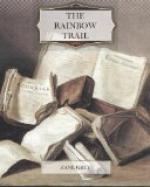For the rest, it was good to be there in the speaking silence, to feel the heat on his outstretched palms and the cold wind on his cheek, to see the black wall lifting its bold outline and the crags reaching for the white stars.
III. KAYENTA
The stamping of horses awoke Shefford. He A saw a towering crag, rosy in the morning light, like a huge red spear splitting the clear blue of sky. He got up, feeling cramped and sore, yet with unfamiliar exhilaration. The whipping air made him stretch his hands to the fire. An odor of coffee and broiled meat mingled with the fragrance of wood smoke. Glen Naspa was on her knees broiling a rabbit on a stick over the red coals. Nas Ta Bega was saddling the ponies. The canyon appeared to be full of purple shadows under one side of dark cliffs and golden streaks of mist on the other where the sun struck high up on the walls.
“Good morning,” said Shefford.
Glen Naspa shyly replied in Navajo.
“How,” was Nas Ta Bega’s greeting.
In daylight the Indian lost some of the dark somberness of face that had impressed Shefford. He had a noble head, in poise like that of an eagle, a bold, clean-cut profile, and stern, close-shut lips. His eyes were the most striking and attractive feature about him; they were coal-black and piercing; the intent look out of them seemed to come from a keen and inquisitive mind.
Shefford ate breakfast with the Indians, and then helped with the few preparations for departure. Before they mounted, Nas Ta Bega pointed to horse tracks in the dust. They were those that had been made by Shefford’s threatening visitor of the night before. Shefford explained by word and sign, and succeeded at least in showing that he had been in danger. Nas Ta Bega followed the tracks a little way and presently returned.
“Shadd,” he said, with an ominous shake of his head. Shefford did not understand whether he meant the name of his visitor or something else, but the menace connected with the word was clear enough.




